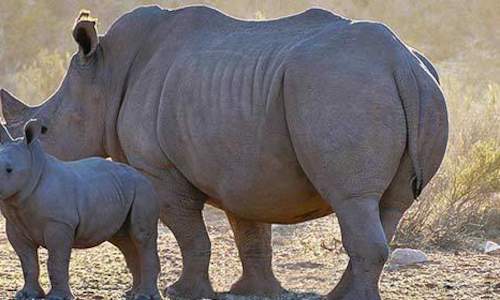
Fuelled by demand from Vietnam, rhino poaching in South Africa shows no signs of abating, with a record 769 rhino killed between January and September 2014. The amount of poached rhino has increased each year over the past few years, despite universal efforts being made to create awareness and put an end to the illegal trade.
In September 2014, SANParks welcomed a group of influential Vietnamese people, from celebrities to top business people, in an effort to educate them on the growing intensity of the crippling effects of the rhino trade. The visit was ultimately aimed at creating an understanding between South Africa and Vietnam, and carried the hope that these influential people would spread awareness on the topic in their country.
More rhinos had been killed in South Africa in the past 10 months of 2011 than were killed in all of 2010, updated poaching numbers revealed. South Africa's grim milestone came on the heels of an announcement by WWF that rhinos had gone extinct in Vietnam. The carcass of Vietnam's last Javan Rhino was found with a gunshot wound and without its horn.
At a meeting of the Convention on International Trade in Endangered Species of Wild Fauna and Flora (CITES) in 2010, the international community concluded that the increase in rhino poaching has been caused largely by demand for horn products in Vietnam. Law enforcement efforts, while increasing, are not yet sufficient to protect rhinos from poachers or stop the smuggling and sale of their horns by organized crime gangs.
"It's hardly surprising the horn was missing from the last rhino as Vietnam is the pre-eminent market destination for illegally sourced rhino horns," says Tom Milliken, TRAFFIC Rhino Programme Coordinator.
In addition to being the biggest consumer of rhino horn, Vietnam is also a major market for tiger parts and other products derived from endangered species. Populations of tigers in the country are alarmingly low and could soon follow the Vietnamese Javan Rhino into extinction.
"The unfounded rumour that rhino horn can cure cancer most likely sealed the fate of the last Javan Rhino in Vietnam," says Dr A. Christy Williams, WWF's Asian rhino expert, "This same problem is now threatening other rhino populations across Africa and South Asia."
Of the five species of rhinoceros, three are critically endangered. With the loss of the Vietnamese Javan Rhino, there are now fewer than 50 Javan rhinos remaining, all in one national park in Indonesia.
"It's tragic that the Javan Rhino has been wiped out in Vietnam by the same forces that are driving rhino poaching in Africa, Milliken added. "This is the ultimate wake-up call for the Vietnamese government to turn aggressively on its internal rhino horn market."
South Africa has been the focal point of poaching because it has the largest population of rhinos in the world. Law enforcement efforts there have been scaled up resulting in more arrests, and some of those convicted are being sentenced to lengthy prison terms.
However, demand for medicinal products containing rhino horn continues to increase in Vietnam and other parts of Asia. Rhino horn has no proven ability to treat cancer and is no longer a part of the official Chinese traditional medicine pharmacopeia.
Despite an international ban on commercial trade under CITES, rhino horn continues to be smuggled illegally from Africa to Asia. Additionally, legal loopholes allowing for the export of rhino hunting trophies are being exploited in some South African provinces. Improvements are needed in the regulation of hunting permits and the management rhino horn stock piles in the country.
"Since armed protection for rhinos in South African national parks is strong, poaching syndicates are likely to shift to countries with weaker enforcement power, possibly including Asian countries that may be caught off-guard," said Dr Carlos Drews, Global Species Programme Director at WWF. "To break the illegal trade chain, governments in source, transit and consumer countries must all scale up their efforts."
A delegation of Vietnamese officials visited South Africa to discuss enhancing law enforcement cooperation between the two countries, and a similar visit took South African authorities to Vietnam for a visit facilitated by TRAFFIC.
"Vietnam should follow South Africa's example and start sending poachers, traders, smugglers and sellers to jail," Dr Joseph Okori, WWF's African Rhino Programme Coordinator. "In order to save rhinos from extinction, the criminal syndicates operating between South Africa and Vietnam must be uncovered and shut down for good."
Rhino Population Statistics in 2013
African species
- Black Rhino: Over 5000 - Slowly increasing
- IUCN Red List: Critically Endangered
- White Rhino: At least 20,400 - Slowly increasing
- IUCN Red List: Near Threatened
Asian species
- Greater-one Horned: More than 3, 300 - Slowly increasing
- IUCN Red List: Endangered
- Javan: No more than 44 - Population stable
- IUCN Red List: Critically Endangered
- Sumatran: No more than 100 - Population decreasing
- IUCN Red List: Critically Endangered
South Africa poaching numbers
- Rhinos poached in/by:
- 2010: 333
- 2011: 448
- 2012: 668
- 2013: 1004
- September 2014: 769
- Arrests in/by:
- 2010: 165
- 2011: 232
- 2012: 267
- 2013: 343
- September 2014: 227
References
International Rhino Foundationhttps://www.rhinos.org/rhinos/state-of-the-rhino-2013
Department of Environmental Affairs
https://www.environment.gov.za/content/updaterhinopoachin_statistics

 Read more on the latest news, facts and figures on Rhino Poaching and Rhino conservation both globally and in South Africa and Kruger Nation...
Read more on the latest news, facts and figures on Rhino Poaching and Rhino conservation both globally and in South Africa and Kruger Nation...